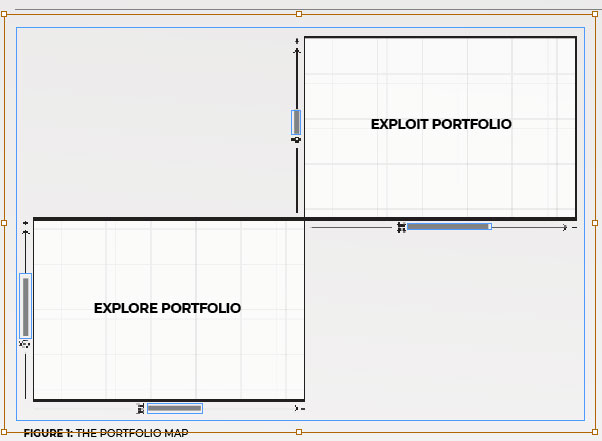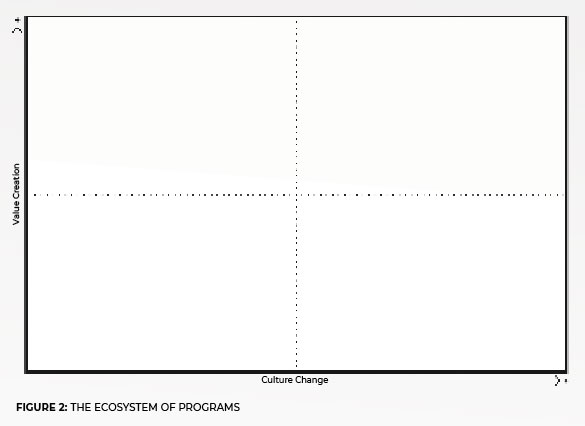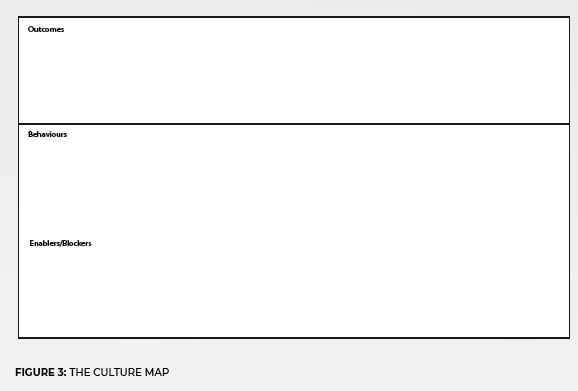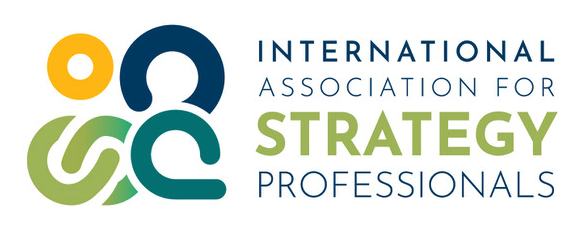By Pierre Hadaya
ABSTRACT
Fueled by trends such as globalization, the digital shift, Industry 4.0, artificial intelligence and agility, innovation is critical to the success and long-term viability of organizations in today’s highly competitive market. In this article, Professor Yves Pigneur talks about tools he has developed together with Alexander Osterwalder to help organizations reap maximum benefits from innovation.
After spending more than 20 years helping entrepreneurs improve their business models, Yves Pigneur, professor at the University of Lausanne, is now determined to help mature organizations better innovate. In his recent book, The Invincible Company, written with long-time collaborator Alexander Osterwalder, as well as Alan Smith and Frederic Etiemble, Yves Pigneur proposes several tools to help organizations improve their innovation. Strategy Magazine talked with professor Pigneur and here are the highlights of our discussion.
Strategy Magazine (SM): After focusing on business models for more than two decades, what has led you to now focus on innovation?
Yves Pigneur (YP): My adventure began when I was approached by students, engineers, and scientists on campus to evaluate their business plan. After reading their business plan, which was mostly based on numbers, and asking them questions, I had the impression that they did not really know what they wanted to do. The business plan did not provide an actual story of their business. To help these entrepreneurs, we decided to develop a tool to help them answer nine key questions about their business (e.g., Who are our customers? How do we address their needs? How will we make money?). This tool became the Business Model Canvas that you know. A few years later, we realized that when designing their business model, entrepreneurs focused more on the easier questions than the more important, but difficult ones. That led us to develop another tool: the Value Proposition Canvas.
When we realized, yet a few years later, that more mature companies had started to adopt both the business model canvas and value proposition canvas, we then became interested in helping these mature organizations manage the plethora of innovation initiatives needed to ensure their constant reinvention and a stronghold in the market. And that is what led us to the new tools we’ve developed, which I’ll talk about today.
SM: Let’s start with the pillars that drive innovation. Can you give us an overview?
YP: A recent McKinsey study shows that although 84% of leaders view innovation as the top driver of growth, only 6% of executives are satisfied with their company’s innovation performance. To alleviate this problem, organizations must rely on three pillars to drive innovation.
The first pillar, Innovation Portfolio, relates to integrating innovation in the normal strategy of the organization. It entails analyzing and shifting the organization’s innovation portfolio from a focus on efficiently dying (i.e., an innovation portfolio dominated by few large-scale bets on efficiency innovation) to growth masters (i.e., a diversified portfolio with many bets that systematically produce winners from efficiency to transformative innovation).
The second pillar, Innovation Programs, entails analyzing and re-designing the organization’s innovation ecosystem to move it from innovation theater (i.e., an ecosystem with many loosely connected or disconnected innovation initiatives) to tangible results (i.e., a strategically integrated and company-wide innovation ecosystem optimized to collaborate and produce results).
The third pillar, Innovation Culture, entails assessing and boosting the organization’s innovation culture by identifying and transforming blockers of innovation (i.e., a culture in which innovation lacks status and legitimacy, and faces many blockers) to enablers of innovation (i.e., a culture in which innovation has power and influence, and enables initiatives).
We have developed three tools to help organizations leverage these three pillars:
1. The Portfolio Map to create an innovation portfolio.
2. The Ecosystem of Programs to minimize innovation theater and maximize the benefits they can reap from innovation.
3. The Culture Map to create an innovation culture.
SM: Please tell us more about the first tool: The Portfolio Map.
YP: As you know, startups spend most of their time exploring new opportunities as part of their strategy, while the strategy and actions of more mature organizations tend to relate to exploiting existing business models. To be successful, however, mature organizations must be good at exploiting both new and current innovations/business models. The Portfolio Map, or Business Portfolio Map, can help leaders close the gaps in their innovation portfolio by probing:
1. The composition of their portfolio and the types of innovations in which they are invested; This means efficiency, sustaining, and transformative innovation investments.
2. Their process for managing an innovation funnel and how good they are at retiring innovation projects. Specifically, the number of ideas they are investing in, killing and taking to scale.
The Portfolio Map (Figure 1) has two quadrants that represent the two sets of innovation portfolios the organization has. The Exploit portfolio (top right) is about managing the existing business and maintaining their growth trajectories. This includes scaling emerging business models, renovating declining ones, and protecting successful ones. Exploit initiatives are placed in this quadrant according to the return they are likely to provide and their risks. The organization must aim to push the exploit innovation initiatives from the bottom left of the quadrant to its top right.
The Explore portfolio (bottom left in Figure 1) is about searching for new value propositions and business models. This process involves designing and testing business ideas, rather than execution. Explore initiatives are placed in this quadrant also according to the return they are likely to provide and their risks. The organization must aim to push the explore innovation initiatives from the bottom left of the quadrant to its top right so that they can eventually be transferred to the Exploit portfolio.
Hence, the Portfolio Map requires two mindsets, one focused on efficiency and execution (top right in Figure 1) and another (bottom left in Figure 1) focused on searching for the right business model, designing and testing those business models, as well as trying to reduce the risk and maximize expected return before moving them to the other portfolio.


SM: What exactly is the second tool: The Ecosystem of Programs?

YP: The Ecosystem of Programs (Figure 2), we developed with Tendayi Viki, is a simple tool that shows the ecosystem innovation programs the organization has, or should have, to drive the previously identified innovation initiatives. Each program is placed in this ecosystem according to the value they will create, and the culture change they will require. Value creation is about the creation of new products, services, value propositions, and business models. The goal of these programs is to manage innovation projects that create new value for the company. Culture change, in turn, is about changing the structure and processes inside the company so that you can innovate in a consistent way.
The R&D lab is an example of an innovation program that can bring a lot of value without requiring an important cultural change (top right quadrant of Figure 2). In turn, having a dedicated innovation board could provide a lot of value, but only if an important culture change is undertaken (bottom left quadrant of Figure 2).
SM: Talk to us about the last tool: The Culture Map.
YP: We are convinced that it is possible to design a culture. We are not talking here about designing a culture like we design a car but rather like we design a garden. Because it is a good tool for representing/visualizing a culture, the Culture Map, we co-designed with Dave Gray, is helpful to organizations in this endeavor. In the middle of the Culture Map (Figure 3) you have the behaviors you can observe in the organization while in the top layer you have the outcomes generated by those behaviors and in the bottom, the enablers and blockers of those behaviors.
By designing the culture like a garden, we mean that just like seeds and water are required for a flower or plant to grow, after a certain amount of time, enablers are required for an organization to obtain an outcome. You cannot act on the behaviors (e.g., CEO spends 40%+ time on innovation, innovation funnel reviewed every quarter and ideas chosen based on evidence) and outcomes (e.g., innovation and growth part of strategy, reduced innovation risk and higher return on R&D) directly. You must eliminate blockers and implement certain enablers in hopes of driving good behaviors and outcomes in the future. These blockers and enablers are of three types:
1. Leadership support:
• Blockers: Lack of innovation strategy, locked into current business model and short-term quarterly focus.
• Enablers: Get strategic guidance, protected resources and portfolio management.
2. Organizational design:
• Blockers: Generate fear of failure, bureaucracy slowing down innovation, and resource system geared toward execution.
• Enablers: Build a bridge between innovation and the core business, create the right incentives and facilitate legitimacy for innovation.
3. Innovation practices:
• Blockers: Linear processes, execution-focused KPIs and lack of skills, knowledge, and experience.
• Enablers: Access to the right innovation tools, methods, processes, and skills.
For example, to create an innovation culture, Ping An, an insurance company in China, has decided to create a new role at the same level of the chief executive officer (CEO). Contrary to the CEO role, which is responsible for the exploitation (i.e., execution) activities/business models, the new role of chief corporate entrepreneur (CCE) is responsible for exploration (i.e., innovation) activities/business models. This ingenious organizational design enabler, which was inconceivable only a decade ago, has enabled the organization to move from around the 400th to the 20th or 30th position in the Financial Times’ Global 500.
SM: As a final question, how would you relate your tools to strategy?
YP: Innovation is a key, but not the sole component of strategy. Indeed, although the traditional tools we have developed (e.g., business model canvas and value proposition canvas) are essential to devise a sound exploitation strategy, they are not enough. Innovation must be on the strategic agenda of leadership because the strengths of your current exploitation business models are likely to decline in the next 10-15 years, if not sooner. If you don’t start your exploration for tomorrow’s ventures right now, the future of the organization will be jeopardized.
Now is the time to make innovation strategic. The organization first must become ambidextrous by devising and realizing both exploitation and exploration initiatives. However, realization is not enough, the organization must be capable of transferring as many exploration initiatives into exploitation initiatives as soon as possible while understanding that many exploration initiatives are likely to fail. The Portfolio Map can help the organization do that.
Second, leadership must decide what kind of innovation programs (e.g., R&D lab, innovation lab, open innovation, or a dedicated innovation board) they need to implement to drive the previously identified innovation initiatives. The Ecosystem of Programs can help the organization do that. And if implementing those innovative programs will require a culture change, leaders also need to eliminate the blockers and enablers that foster the right behaviors which lead to the right outcomes for the targeted innovation program. The third and last tool, Culture Map, can help the organization do that.
ABOUT THE AUTHOR
Pierre Hadaya, PhD, is a professor at the School of Management of Université du Québec à Montréal. As Co-Founder of ASATE Group Inc., Dr. Hadaya also collaborates with organizations striving to transform themselves so they can develop a competitive advantage.
E: This email address is being protected from spambots. You need JavaScript enabled to view it.







